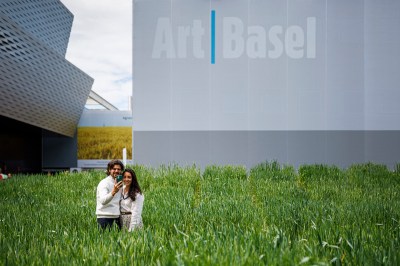Editor’s Note: This story originally appeared in On Balance, the ARTnews newsletter about the art market and beyond. Sign up here to receive it every Wednesday.
If one were to go by the first-day sales results of last month’s Art Basel, one might come away with the impression that the fair was a relative success. For the megas, that might be true. David Zwirner started the fair by selling a Joan Mitchell diptych for $20 million, and Hauser & Wirth sold its most expensive offering, a $16 million Arshile Gorky work, despite noticing a slowed pace. By the end of the fair, Pace had sold its star Agnes Martin painting for a reported $14 million.
But upstairs at the fair, where smaller and mid-size galleries typically reside, rumors were flying that delicate changes in the market weather were being more acutely felt. These dealers are facing thinner margins, rising shipping and material costs, inflation, and more cautious collectors. The risk, as dealer René-Julien Praz recently told Le Quotidien de l’Art, is “enormous.” Praz recently closed his gallery, the Paris- and Los Angeles–based Praz-Delavallade; he said the high total cost for exhibiting in the international fair circuit contributed to the decision.
Transportation, insurance, on-site personnel, and booth fees all add up. “During one participation at Art Basel Miami, we left Florida with an $80,000 deficit,” he told Le Quotidien de l’Art. “It’s like playing Russian roulette every time.”
Now, a month on from the fair, with the art calendar’s summer respite in full swing, ARTnews spoke with several small and medium-size galleries, most of whom were at Art Basel, and one at Liste, to discuss the current market.
None of the galleries found the most recent Art Basel to be a bust, with top-line impressions including “surprisingly well,” “relieved,” “better than expected,” and “good sales and a general positive sensation.” One gallery, Paris’s Galerie Jocelyn Wolff, went so far as to say it was “one of our best” fair outings. (However, that assessment by founder Jocelyn Wolff came with the caveat that the gallery has “never sold out an exhibition at the gallery or a booth at the fair.”)
And yet, there was a definite sense among dealers that the market is in a far different place from 2019, or even from the first fair after the start of the pandemic. As Alex Mor, cofounder of Mor Charpentier (of Paris and Bogotá), told ARTnews, “Art Basel remains the most prestigious fair, where we bring the best works, and where you have connections with people that you usually don’t connect with … But I think the level and the volume has decreased.”
Dealers said the sales activity at Basel and Liste was not uniform. Some reported making numerous sales on the first day, as has been typical, while others described a move further away from the “one-day fair,” where sales mostly happen during the opening, and offer a good indication of how the fair will go from there. It should be noted that smaller galleries tended to say they have traditionally made sales through the week at Art Basel, with the first day setting the tone. Now, collectors are putting down holds and dealers are selling unevenly through the weekend.
That slower atmosphere tracks, dealers said, with an “overall slowdown” in the market over the last six months to a year. “Collectors are being very discerning, which I think is a good thing, but it’s gone back to a slower pace that was very over-accelerated since Covid,” Chicago-based dealer Monique Meloche told ARTnews. “Covid happened and the market went crazy, but that wasn’t real. That pace can’t be maintained.”
To Wolff, the slowdown is less about a lack of collectors willing to buy, but rather comes down to a “pricing-trust issue.”
Wolff traced this to a combination of high primary prices for some mid-career artists on fast tracks, while the value that institutions have typically lent to contemporary artists “is weaker than before.” Museums’ “stamp of approval is being challenged,” and is “less readable” today, he said, particularly for collectors less interested in certain identity-themed works popular in institutional exhibitions.
“There was always a little gap between the values promoted by the art market and the values promoted by the museum,” said Wolff. “But it is a little more complex today and prices are higher.”
For these smaller and mid-size galleries, however, the slowdown makes the calculus around fairs trickier, particularly when you consider the overhead for a fair. As multiple dealers told ARTnews, shipping, framing, storage, and other overhead costs have risen dramatically, with Meloche suggesting that such costs are “at least 50 percent higher” than pre-Covid. Those costs are felt by collectors too, who Meloche said continue to gravitate toward paintings, due to the efficacy in those costs.
“I don’t complain,” José Kuri, cofounder of Kurimanzutto (of Mexico City and New York), told ARTnews of Art Basel. “We did well, but it’s true that the shipping on average costs are way higher, than two, three years ago, and so the margins are way lower. So, you can feel that.”
Those issues are especially pronounced for galleries hailing from the Global South. As Catalina Casas, founder of Bogotá gallery Casas Riegner, told ARTnews, South American galleries need to do the fairs “because that activates our market, in a way,” but the costs make it difficult to compete.
“But what I think the art world needs to think about, if they want us to survive, is: under what conditions are we going to compete?” Casas said. “We are basically participating under the same conditions of the galleries who occupy the upper side of the market, where I would have to sell my whole booth to amount to one work in a major gallery.”

Visitors to Art Basel take a selfie in front of Agnes Denes’s installation Wheatfield – A Confrontation (2024), in the Messeplatz.
Photo Valentin FLAURAUD / AFP
At the fair, which she described as better than last year, the gallery presented works ranging from $7,000 to $95,000. But it’s hard to totally evaluate this year’s performance when deals started at the fair are still being negotiated.
Always looming above the market in recent years, and especially over the last 12 months, has been geopolitics, which all the dealers agreed have resulted in collectors being cautious and, in some cases, not traveling at all. The wars in Ukraine and Gaza, and the turbulence in elections across the US and Europe, among other issues, have created “a climate of uncertainty,” according to Kuri.
“People are holding onto their assets, not spending in the way it used to be,” Kuri said. “Everyone’s waiting to see what will happen, so this might create a tighter market, so it’s not as liquid as it was in the last couple of years.”
While the tight market has led some to conclude that collectors are looking for “safer,” more established names, all the gallerists interviewed emphasized staying the course with their unique programs, and even taking on more risk.
Mor Charpentier, for example, is set to open a new Paris space in the Marais district in October timed to Art Basel’s French fair that is double the size of their current location. The gallery is also investing in its residency program in Colombia. Jochen Meyer, cofounder of Berlin’s Meyer Riegger, has opened a new gallery in Seoul in lieu of participating in multiple Asian fairs each year, with the hope that a permanent space helps build long-term relationships in Korea and Asia more generally. Barcelona’s Bombon Projects has continued to develop its summer space opened in collaboration with Prats Nogueras Blanchard (in Barcelona and Madrid) in the Spanish countryside during Covid.
“It is true that fairs are necessary, they give you visibility and sales, especially if you come from a place like Barcelona that is not in the center of the art world, but this collaborative spirit that we experienced during Covid in which you could share energies, artists, collectors and costs is definitely something to continue bearing in mind,” the gallery told ARTnews in an email.
For Meloche, staying the course means continuing to move slowly and steadily with their artists, and working harder to meet collectors where they are at, whether visiting them in their homes, having more serious in-depth conversations about an artist’s work and practice, and collaborating with other galleries to sell together.
“It’s the moment also that you have to insist on who you are,” Kuri of Kurimanzutto said. “You cannot change your face at this moment or just go with the market. I think that will be very harmful for the artists.”
This post was originally published on this site be sure to check out more of their content






